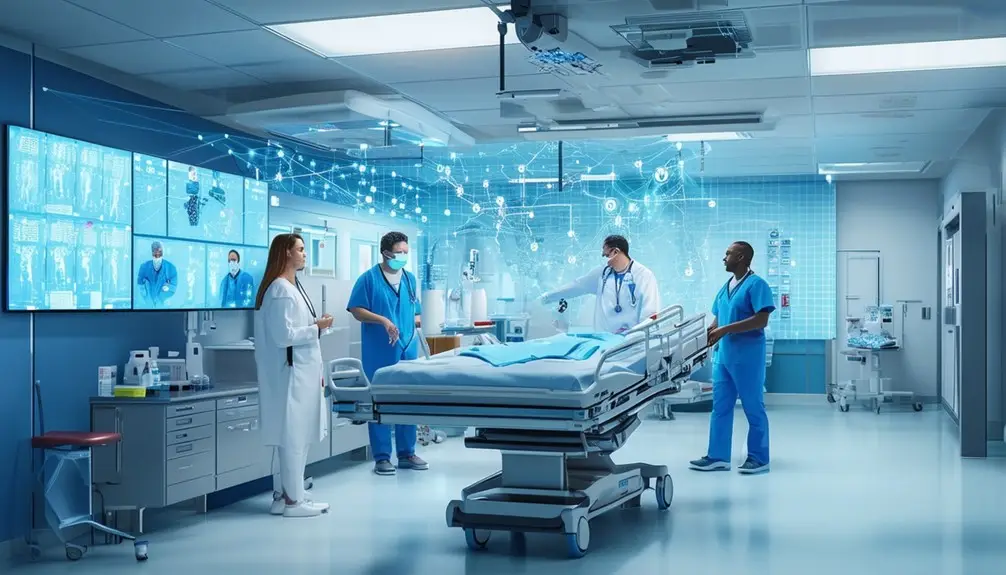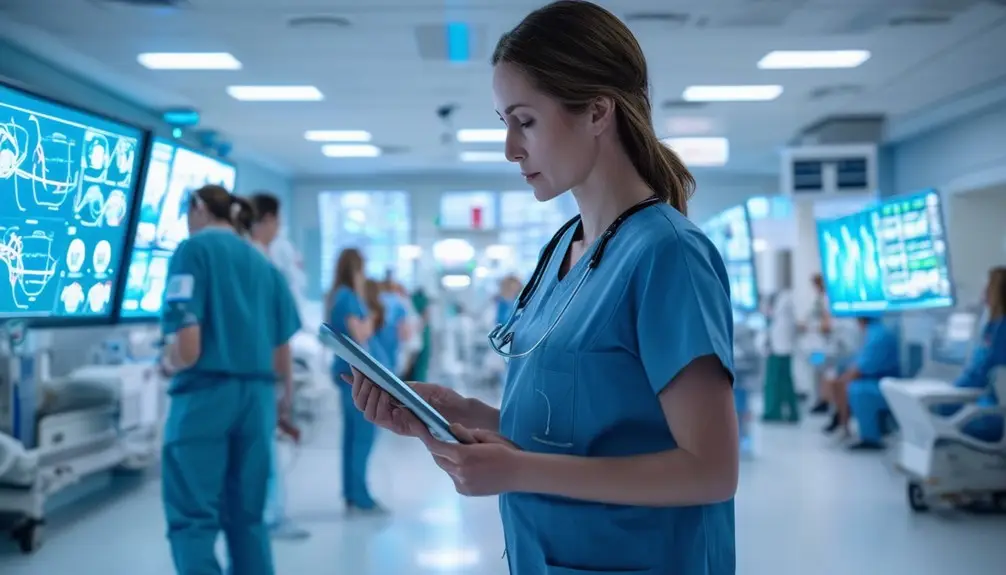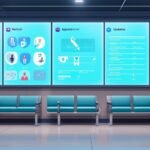Implementing Real-time Location Systems (RTLS) in ERs can significantly enhance patient flow. RTLS monitors patient locations, staff availability, and resource allocation in real-time, decreasing wait times and improving efficiency. By identifying bottlenecks promptly, you can take immediate corrective actions and streamline operations. Integrating RTLS with wearable tech and instant messaging systems guarantees faster interventions and improved communication. Data-driven scheduling minimizes appointment overlaps and optimizes resource utilization. Ultimately, these digital solutions boost patient safety and care quality. Explore how these technologies can transform your ER’s efficiency with additional insights and solutions.
Key Takeaways
- RTLS technology provides real-time data on patient locations, staff availability, and equipment, enhancing operational efficiency.
- Automated scheduling systems reduce appointment overlaps and manage peak times, improving emergency department throughput.
- Real-time messaging systems streamline communication, ensuring quick response and coordinated care.
- Patient wearables integrated with RTLS allow for real-time monitoring and faster intervention.
- Staff location badges using RTLS optimize resource allocation and improve workflow efficiency.
Understanding Patient Flow
To enhance patient flow in the emergency department, tracking and managing the real-time movement of patients, staff, and resources is crucial. Utilizing Real-Time Location Systems (RTLS) improves your ability to accurately monitor these movements. RTLS technology provides precise data on patient locations, staff availability, and the status of critical resources. This real-time data is invaluable for reducing wait times and improving overall efficiency.
By implementing RTLS, you can identify bottlenecks as they occur, allowing for immediate corrective actions. For instance, if you observe a backlog at triage, you can swiftly allocate additional staff to that area. This proactive approach minimizes delays and ensures patients receive timely care. RTLS data helps optimize resource allocation. Knowing precisely where staff and equipment are located enables you to deploy them more effectively, further reducing wait times.
Analyzing RTLS data also provides insights into peak times and patient flow patterns. These insights enable you to adjust staffing levels and resource availability in advance, preventing potential delays. Overall, RTLS technology is a powerful tool for understanding and managing patient flow, guaranteeing your emergency department operates at peak efficiency.
Key Factors Impacting Flow
To improve ER patient flow, you need to address key factors such as limited resource challenges, communication breakdown issues, and inefficient scheduling bottlenecks. Data shows that optimizing these areas can greatly enhance throughput and patient satisfaction. Implementing targeted digital solutions can streamline operations and mitigate these common obstacles.
Limited Resource Challenges
Frequently, the efficiency of patient flow in the emergency department is greatly hindered by challenges related to limited resources, such as staffing, equipment, and space allocation. These bottlenecks directly impact the ability to enhance patient flow, ultimately leading to longer wait times and declining the quality of care delivered.
Staffing shortages are a primary issue. When there aren’t enough qualified healthcare professionals to handle the influx of patients, delays become inevitable. Data-driven staffing models that predict peak times can assist in optimizing workforce allocation, thereby reducing wait times.
Equipment shortages also pose significant challenges. The lack of critical medical devices can slow down diagnostics and treatment processes. Implementing an inventory management system that tracks equipment usage and availability in real-time can mitigate these delays.
Space allocation is another crucial factor. Overcrowding due to limited space can create bottlenecks. Utilizing digital floor plans and predictive analytics to manage space more effectively can enhance patient throughput.
Addressing these resource limitations is essential for improving patient flow and ensuring timely, effective care. Leveraging digital solutions to manage staffing, equipment, and space more efficiently can greatly enhance the emergency department’s operational efficiency.
Communication Breakdown Issues
Communication breakdowns in the emergency department can severely disrupt workflow and impede patient flow, necessitating robust digital solutions to mitigate these issues. When communication falters, bottlenecks and delays in patient care are inevitable, directly impacting the efficiency of the ER. Here are three pivotal factors to contemplate:
- Ineffective Communication Tools: Without modern, efficient communication tools, staff coordination and patient management suffer. This leads to delayed responses, increased wait times, and a chaotic environment. Implementing digital platforms like real-time messaging systems can substantially enhance patient flow.
- Errors and Confusion: Poor communication can result in medical errors and confusion among staff, compromising patient safety. Digital solutions such as electronic health records (EHRs) with integrated communication features ensure that all team members have access to consistent and accurate information, reducing the risk of errors.
- Staff Coordination: Effective staff coordination is vital for maintaining smooth operations in the ER. Digital solutions like task management software can help streamline workflows by assigning and tracking tasks in real-time, ensuring that no critical steps are missed and patient flow is optimized.
Inefficient Scheduling Bottlenecks
Inefficient planning procedures create significant obstacles in patient flow, disrupting the timely progression through various care phases in the emergency department. Overlapping patient appointments due to poor planning exacerbates congestion, leading to delays in critical care delivery. When planning is not optimized, you’ll find that patients experience prolonged wait times, which in turn negatively impacts their overall satisfaction and outcomes.
Data-driven patient flow solutions are vital to address these inefficiencies. By leveraging advanced planning algorithms and predictive analytics, you can greatly improve the allocation of resources and streamline patient throughput. For instance, implementing automated planning systems can minimize appointment overlaps and better manage peak times, ensuring the emergency department operates smoothly.
These solutions can continuously analyze and adapt to real-time data, offering dynamic adjustments to the schedule as patient volume fluctuates. This proactive approach not only enhances operational efficiency but also guarantees that patients receive timely care. By focusing on refining planning practices, you’ll find that the overall flow and efficiency of the emergency department improve, ultimately leading to better patient outcomes and higher staff satisfaction. Addressing planning obstacles is crucial for a well-functioning emergency department.
Digital Improvement Strategies

Implementing digital improvement strategies like RTLS devices and staff location badges greatly streamlines emergency department workflows by enhancing communication and visibility. These tools offer a data-driven approach to monitoring patient movement and optimizing staff efficiency.
Here are three crucial strategies you should consider:
- Patient Wearables: Utilizing patient wearables integrated with RTLS devices ensures you can monitor patient essentials in real-time. This proactive communication reduces response times, enhances patient safety, and improves overall care delivery. Data from these wearables can predict patient needs, thereby enabling quicker intervention.
- Nurse Call Integration: Integrating nurse call systems with RTLS technology facilitates immediate staff response. This integration guarantees that alerts are sent directly to the nearest available nurse or medical professional, effectively reducing wait times and enhancing patient care efficiency.
- Equipment Tracking: By embedding RTLS tags on essential medical equipment, you can guarantee immediate recovery and availability of critical tools. This minimizes delays in patient care and expedites critical medical procedures.
Efficient patient flow management systems like PatientTrak offer real-time insights, allowing you to identify and resolve bottlenecks promptly. By leveraging these technologies, you can significantly enhance emergency department operations, leading to improved patient outcomes and higher staff productivity.
Staff Location Solutions

Using RTLS badges for real-time staff tracking greatly enhances workflow efficiency and resource allocation. You’ll see improved response times and optimized team deployment, directly impacting patient care quality. Integrating this technology guarantees your emergency department operates at peak performance.
Real-Time Staff Tracking
By leveraging Real-Time Location Systems (RTLS) badges, Emergency Departments can precisely track staff locations, optimizing workflow and enhancing patient care efficiency. RTLS technology streamlines the flow of operations by providing real-time data on staff movements. This immediate visibility reduces bottlenecks and guarantees that staff are allocated where they are most needed, directly impacting patient outcomes.
Here are three significant benefits of implementing RTLS for staff tracking in Emergency Departments:
- Enhanced Workflow Efficiency: RTLS badges enable instant identification of staff locations, allowing for quicker decision-making and reduced wait times for patients.
- Improved Patient Care: Integrating RTLS with nurse call systems guarantees that staff can respond promptly to patient needs, improving overall care quality.
- Increased Safety: RTLS badges come with discreet alert functionalities, offering an additional layer of protection against workplace violence and enhancing staff safety.
Optimized Resource Allocation
RTLS badges offer precise, real-time data on staff locations, allowing Emergency Departments to allocate resources more effectively and improve patient care. When you use RTLS devices, staff locations are automatically updated, enabling streamlined workflow management. This guarantees that the right personnel are in the right place at the right time, decreasing wait times for patients and enhancing overall ER efficiency.
Integrating nurse call systems with staff location solutions further optimizes resource allocation. As a result, nurses can respond to patient needs more rapidly, ensuring timely care and enhancing patient satisfaction. The real-time location validation provided by RTLS devices also supports supervisors in making data-driven decisions about resource distribution, thereby improving operational efficiency.
Additionally, RTLS badges play a vital role in workplace violence protection. They enable discreet alerts that can be triggered in emergency situations, ensuring staff safety and allowing for rapid intervention. By accurately identifying staff locations and automatically updating their positions, RTLS badges facilitate a safer, more responsive ER environment. To sum up, leveraging RTLS technology in the ER setting is essential for optimizing resource allocation, reducing wait times, and enhancing both patient and staff experiences.
Patient Tracking Methods
Effective patient tracking methods, such as real-time location systems (RTLS) devices and wearables, enhance visibility and communication within the Emergency Department. By implementing these technologies, you can optimize response times, streamline workflow, and ultimately improve patient care. Real-time data from patient tracking solutions allows you to identify bottlenecks quickly, reduce wait times, and enhance safety for both patients and staff.
Here are three key advantages of using patient tracking methods:
- Enhanced Visibility: RTLS badges for staff and patient wearables provide real-time location information, enabling you to effectively monitor patient movements and staff availability.
- Improved Communication: These systems facilitate seamless communication between team members, ensuring that critical information is relayed promptly to the right individuals.
- Reduced Wait Times: By identifying and addressing bottlenecks in real-time, you can significantly decrease wait times, leading to higher patient satisfaction and better outcomes.
Integrating patient tracking methods into your ER operations boosts efficiency and contributes to overall operational excellence. Leveraging these data-driven solutions ensures that every step of the patient journey is optimized, enhancing the quality of care and operational performance.
Asset and Equipment Tracking
Leveraging asset and equipment tracking in the emergency department guarantees that essential tools are always available precisely when needed, streamlining patient care and operational efficiency. Real-time asset tracking confirms that equipment like ventilators, defibrillators, and infusion pumps are easily locatable, minimizing patient wait times and enhancing the overall workflow.
Employing asset tracking solutions efficiently captures asset exchanges, ensuring every piece of equipment is accounted for and readily accessible. This technology reduces the time spent searching for tools, thereby speeding up critical care delivery and optimizing resource allocation.
| Benefit | Description |
|---|---|
| Reduced Patient Wait Times | Ensures faster availability of essential equipment for immediate patient care. |
| Streamlined Operations | Tracks asset locations in real-time, facilitating efficient workflow processes. |
| Optimized Resource Allocation | Uses location data to distribute equipment effectively across the department. |
Implementing these solutions means that hospitals can respond more promptly in emergencies, directly impacting patient outcomes. With real-time location data, you can make informed decisions about where to deploy resources, guaranteeing that each patient’s needs are met promptly. Asset tracking enhances efficiency and supports a higher standard of patient care by ensuring no critical moment is lost due to equipment unavailability.
Conclusion
By implementing cutting-edge digital solutions, you won’t just improve patient flow—you’ll revolutionize it. With precise staff location tools, real-time patient tracking, and advanced asset management, you’ll streamline operations like never before. These technologies don’t just enhance efficiency; they empower your healthcare team to deliver unparalleled care. Embrace these innovations, and watch your facility become a beacon of excellence in the medical community.
Frequently Asked Questions
What Is Patient Flow Software?
Patient flow software optimizes patient movement through care stages, managing capacity, reducing wait times, and planning discharges. It offers real-time visibility and predictive analytics and enhances communication and coordination for improved operational efficiency and patient outcomes.
How Does Patient Flow Work?
Patient flow works by efficiently moving patients through care phases, relying on precise scheduling, effective communication, and resource management. Implementing RTLS devices, nurse call systems, and patient wearables can optimize handovers and improve overall efficiency.





